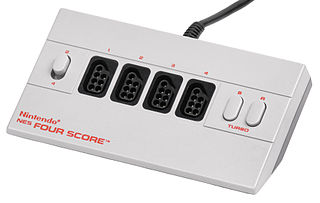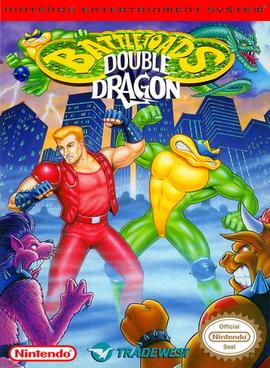
NBA Jam is a basketball video game developed and published by Midway for arcades in 1993. It is the first entry in the NBA Jam series. The project leader for this game was Mark Turmell.
A sports video game is a video game that simulates the practice of sports. Most sports have been recreated with video games, including team sports, track and field, extreme sports, and combat sports. Some games emphasize playing the sport, whilst others emphasize strategy and sport management. Some, such as Need for Speed, Arch Rivals and Punch-Out!!, satirize the sport for comic effect. This genre has been popular throughout the history of video games and is competitive, just like real-world sports. A number of game series feature the names and characteristics of real teams and players, and are updated annually to reflect real-world changes. The sports genre is one of the oldest genres in gaming history.

Battletoads is a platform beat 'em up developed by Rare and published by Tradewest. It is the first installment of the Battletoads series and was originally released in June 1991 for the Nintendo Entertainment System. It was subsequently ported to the Mega Drive and Game Gear in 1993, to the Amiga and Amiga CD32 in 1994, and released with some changes for the Game Boy in 1993 in the form of Battletoads in Ragnarok's World. In the game, three space humanoid warrior toads form a group known as the Battletoads. Two of the Battletoads, Rash and Zitz, embark on a mission to defeat the evil Dark Queen on her planet and rescue their kidnapped friends: Pimple, the third member of the Battletoads, and Princess Angelica.

Plok! is a side-scrolling platform game developed by British studio Software Creations using concepts and characters created and owned by Ste and John Pickford. It was released for the Super Nintendo Entertainment System (SNES) in late 1993 by Tradewest in North America, Nintendo in Europe, and Activision in Japan. Players portray the hood-headed titular protagonist, the king of the island Akrillic who is protecting it from fleas spawned by the Flea Queen, who is under the island's ground, as well as other bosses trying to overthrow Plok's power. His versatility lies in his four separable limbs, which can be used to shoot at targets and enemies, and several power-ups scattered throughout its colorful stages as "presents."

The NES Four Score is a multitap accessory created by Nintendo in 1990 for the Nintendo Entertainment System. Select games can utilize it to enable up to four-player gameplay. The NES Four Score is similar to the previously introduced NES Satellite, a device that allows four players to connect to the NES and extends the range using infrared wireless communication.

Battletoads/Double Dragon is a 1993 beat 'em up developed by Rare and published by Tradewest. It was originally released for the Nintendo Entertainment System and later ported to the Mega Drive/Genesis, Super NES, and Game Boy. Retro-bit Publishing has re-released the 8-bit NES version in early 2022 with plans to release the 16-bit versions later this year.

Cyberball is a video game released in arcades in 1988 by Atari Games. The game is a 7-man American football using robotic avatars of different speeds, sizes, and skill sets set in the year 2022. Originally released for arcades, Cyberball was ported to several home consoles and computers.

R.C. Pro-Am II is a racing video game developed by Rare and released by Tradewest for the Nintendo Entertainment System on December 11, 1992. The game is the sequel to the 1988 R.C. Pro-Am and features similar gameplay with a wider variety of tracks, currency-based vehicle and weapon upgrades, and bonus stages. In R.C. Pro-Am II, four players, either human or artificial intelligence, race on a series of tracks to finish first while avoiding obstacles and hazards. The winner receives race points and money. The game features a multiplayer mode in which up to four human players can compete against each other simultaneously.
A cooperative video game, often abbreviated as co-op, is a video game that allows players to work together as teammates, usually against one or more non-player character opponents (PvE). Co-op games can be played locally using one or multiple input controllers or over a network via local area networks, wide area networks, or the Internet.

Double Dribble is an arcade basketball video game developed and released by Konami in 1986. It was the second basketball arcade video game by Konami, following Super Basketball. It was considered the most realistic basketball sports video game upon release, with fast-paced action, detailed players, a large side-scrolling court, innovative cinematic slam dunks, and detailed sound effects, beginning a trend where presentation would play an increasingly important role in sports games.

Double Dragon is a 1987 beat 'em up video game developed by Technōs Japan and distributed by Taito for arcades across Asia, North America and Europe. It is the first title in the Double Dragon franchise. The game's development was led by Yoshihisa Kishimoto, and it is a spiritual and technological successor to Technos' earlier beat 'em up, Nekketsu Kōha Kunio-kun (1986), released outside of Japan by Taito as Renegade; Kishimoto originally envisioned it as a direct sequel and part of the Kunio-kun series, before making it a new game with a different cast and setting.

M.C. Kids is a 1992 platform video game developed and published by Virgin Interactive. It was initially released for the Nintendo Entertainment System in February 1992 in North America, and by Ocean Software in May 1993 in Europe. As a licensed product for the McDonald's fast food restaurant chain, the game stars two children named Mack and Mick who venture into the fantasy world of McDonaldland in order to return Ronald McDonald's magical bag which has been stolen by the Hamburglar. The game was created by four people in eight months: Darren Bartlett Gregg Iz-Tavares and Dan Chang (programming) and Charles Deenen (audio).

Side Pocket is a pocket billiards simulation released as an arcade video game by Data East in 1986. It was ported to the Nintendo Entertainment System and Game Boy, while an enhanced remake was later released on the Sega Genesis, Super Nintendo Entertainment System, and Game Gear. The game spawned two sequels, as well as arcade spin-off series titled Pocket Gal.

WWF WrestleMania is a professional wrestling arcade game released by Midway Manufacturing Co. in 1995. It is based on the World Wrestling Federation (WWF) professional wrestling promotion.

Troy Aikman NFL Football is an american football video game originally developed by Leland Interactive Media and published by Tradewest for the Super Nintendo Entertainment System first in North America on August 1994. Officially licensed from the National Football League, it prominently features former NFL player Troy Aikman, who became the first member of the 1993 Dallas Cowboys to have his namesake in a game, followed by his teammate Emmitt Smith in Emmitt Smith Football.

Danny Sullivan's Indy Heat is a 1991 racing game developed and published in arcades by Leland Corporation. It stars American IndyCar driver Danny Sullivan, and features the tracks of the CART series of the early 1990s. Home versions of the game were released for the Nintendo Entertainment System, Amiga, Atari ST, and Commodore 64.

Bo Jackson Baseball is a baseball video game for the Nintendo Entertainment System, Amiga, TurboGrafx-16, and MS-DOS. It features athlete Bo Jackson, then a star in professional baseball and a former professional football player. In Europe, it was released by Mindscape as TV Sports: Baseball, part of the TV Sports series including TV Sports: Basketball and other games based on hockey and American football.
There have been a variety of Sesame Street video games released for video game platforms. Most of the Sesame Street video games were published and developed by NewKidCo.

NBA 2K12 is a 2011 basketball simulation video game developed by Visual Concepts and published by 2K. It was released in October 2011 for Microsoft Windows, PlayStation 2, PlayStation 3, PlayStation Portable, Wii, Xbox 360, and, for the first time, iOS. As the thirteenth installment in the NBA 2K series, it is the successor to NBA 2K11 and the predecessor to NBA 2K13. For the first time in the series, three different covers are available; the three cover athletes are Michael Jordan for the Chicago Bulls, Magic Johnson of the Los Angeles Lakers, and Larry Bird of the Boston Celtics. This was the last installment in the series to be released for the PlayStation 2.

Goal! Two is a soccer (football) video game developed by Tose for the Nintendo Entertainment System (NES), and published by Jaleco in 1992. Goal! Two is Tose's first sequel to the NES title Goal!. On 04/24/92, Tose's first soccer title for the Super Famicom, Super Cup Soccer (スーパーカップサッカー) was published by Jaleco. It was later ported to the Famicom on 09/25/92 as Goal!!. Jaleco localized the Famicom game for the NES as Goal! Two for North American markets, and Goal! 2 for European markets later that year. Finally, the Super Famicom version was brought to the Super NES (SNES) as Goal! for North America and Super Goal! for Europe in December 1992, shortly after Goal Two! for the NES. The cover model is John Brady, an amateur soccer player from London who was living in Chicago.

















